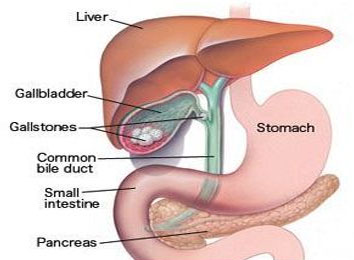What is Cholecystectomy?
The surgical procedure that removes the gall bladder is known as Cholecystectomy. The gallbladder is responsible for storing bile (a substance produced by the liver that helps in breaking down fat for the purpose of digestion).
This surgical procedure was earlier performed by making an incision at the right side of the upper abdomen but now it is performed by using a laparoscope that involves only 3-4 small incisions.
Types of Cholecystectomies
There are two ways for removing gallbladder that include –
- Laparoscopic Method: A laparoscopic Cholecystectomy procedure makes use of more than three laparoscopes, 2-3 small incisions and a thin small tube which is attached with a video camera. This video camera helps in visualizing the abdomen from within while performing the operation. The removal of the gall bladder is done from any one of the incisions. This method is less invasive and involves shorter recovery time as compared to open Cholecystectomy.
- Open Method: This method involves making 2-3 inch incision at the upper hand side of the abdomen. The gallbladder is then located and removed from this incision.
Candidates for Cholecystectomy
Candidates for Cholecystectomy usually possess following conditions –
- Chronic acalculous gallbladder disease, also known as biliary dyskinesia, is the disease where gallbladder does not empty quickly and results in biliary colic
- Severe gallstone attack
- Pancreatitis which is the inflammation of the pancreas is secondary to gallstones
- Endoscopic sphincterotomy for common bile duct stones
- High risk for gallbladder cancer
- Certain less severe gallstone attack
- Cholecystitis (gallbladder inflammation)
Gallstones
Calcium carbonate, cholesterol and calcium bilirubinate chemicals get unbalanced then it may form gallstones. Gallstones are categorized into two types –
- Pigment Gallstones: When there is too much of bilirubin then these gallstones are formed. These gallstones are more commonly seen in those people who are suffering from liver disease, blood disorders or infected bile tubes that include sickle-cell anemia.
- Cholesterol Gallstones: When there is too much cholesterol forms in the bile then it results in cholesterol gallstones.
Symptoms of Gallstones
It has been seen in many cases that people suffering from gallstones usually develops no symptoms. The reason for this is that these gallstones stay inside the gallbladder without resulting into any problem. Some of its symptoms are –
- Restlessness
- Pain on the right side of the body that is just below the ribs
- Vomiting
- Back pain
- Pain in the right shoulder
- Sweating
- Nausea
Diagnosis for Gallstones
Usually gallstones are discovered when a patient is being diagnosed for some other condition. These gallstones are discovered after an ultrasound test, a blood test, an x-ray, a cholesterol test or an ultrasound scan. The signs of obstruction, jaundice, infection or pancreatitis are determined by performing blood tests. The different types of tests include –
- CT scan (Computerized tomography scan): The cross-section pictures of within the body are produced by this non-invasive test.
- Cholangiography: This test involves the injection of a dye into the blood stream for concentrating into the gallbladder or bile ducts. Another way is to insert the dye directly into the bile duct by suing an endoscope. This dye presents itself on the x-rays.
- Cholescintigraphy (HIDA scan): This test involves the injection of a harmless radioactive material in small quantity into a patient. Gallbladder then absorbs this material. This test helps in determining blockage of the bile duct or unusual contraction of the gallbladder.
Treatment for Gallstones
Treatment of gallstones is only done when gallbladder has resulted in the blockage of the bile ducts, inflammation in the gallbladder or when the gallbladder has moved into the intestines. Low fat diet is recommended for the patients who are being treated.
Ursodeoxycholic acid
Ursodeoxycholic acid helps in dissolving cholesterol gallstones. This treatment can be completely effective in 24 months.
Lithotripsy
The gallstones are ruptured with the help of ultrasonic shock waves. If the gallstones are small then they can easily pass from the stool of the patient. This treatment is only done when there are less gallstones.
Cholecystectomy
The surgical procedure of Cholecystectomy is performed for removing the gallbladder. This procedure is done with minimal invasive surgery where a tiny incision is made. A large incision is made in open Cholecystectomy in the abdomen of a patient. If there is severe inflammation in the gallbladder then open surgery is required.
Robotic Laparoscopic Cholecystectomy Procedure
This is minimally invasive robotic procedure is performed for removing the gallbladder. The 3-D high definition images are viewed by the surgeon who also moves robotic arms that are connected with surgical instruments. The system precisely imitates the movements of the wrist, hand and fingers of the surgeon that provides real movements of surgical instruments within the patient. This procedure only requires 3-4 small incisions and a single incision is done at the belly button from where the diseased organ is removed. This procedure is a recommended treatment for non-functioning gallbladder and gallbladder pain from gallstones. Some of its benefits include –
- Shorter hospital stay
- Minimal scarring
- Quick recovery
- Less bleeding
- Less pain
Cost of Cholecystectomy
Laparoscopic Cholecystectomy in India is performed at a very low cost. India is known for its latest medical facilities where all the surgeries are performed by well-trained surgeons.

